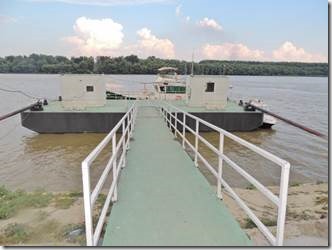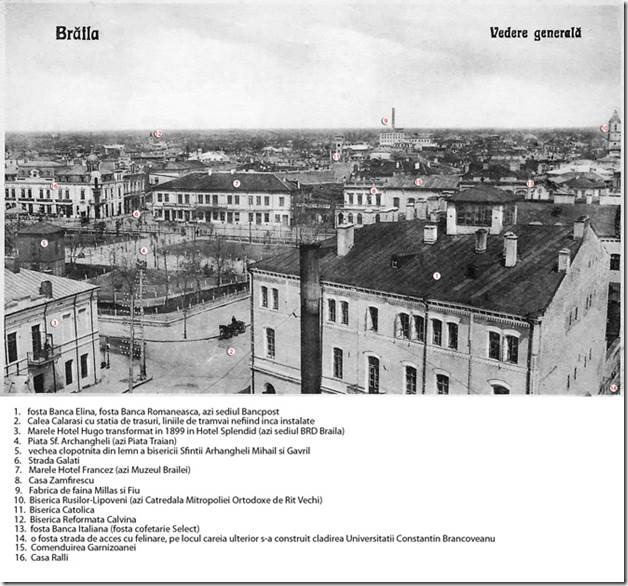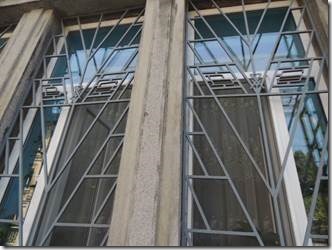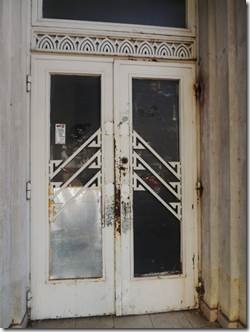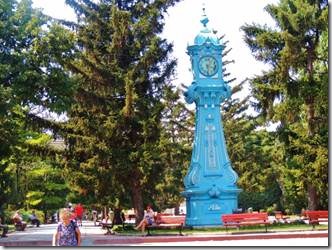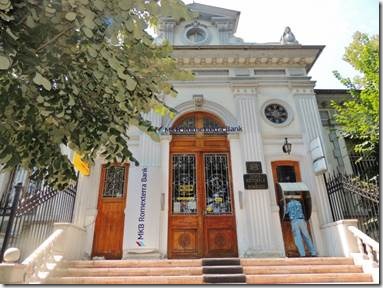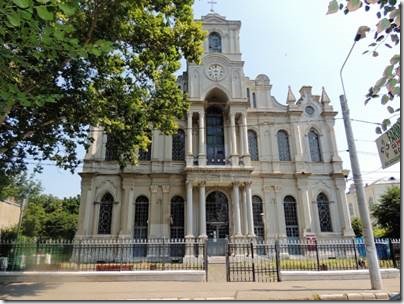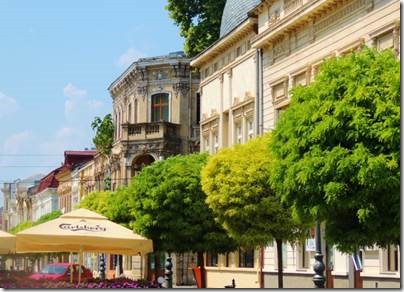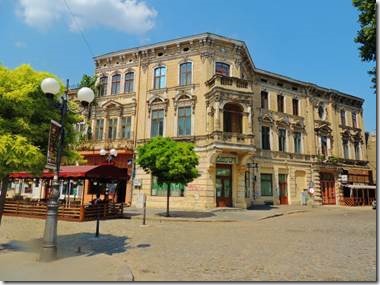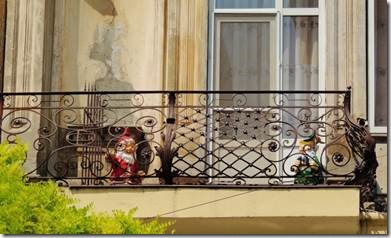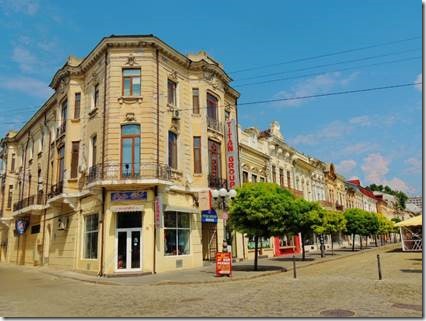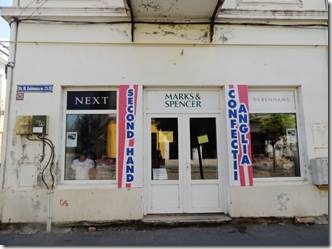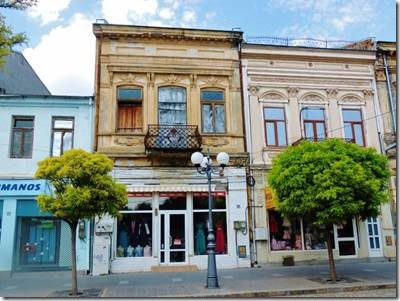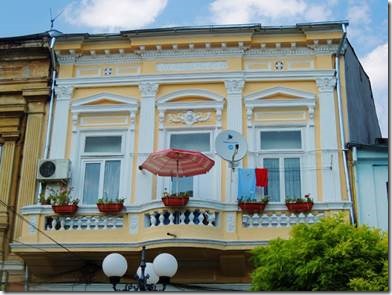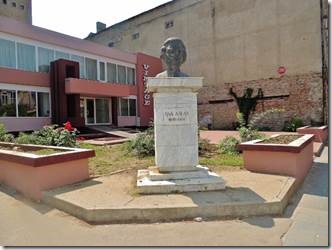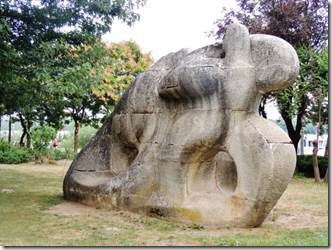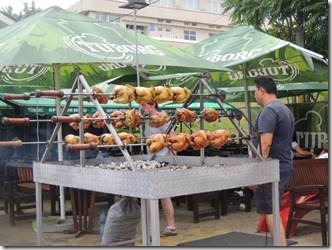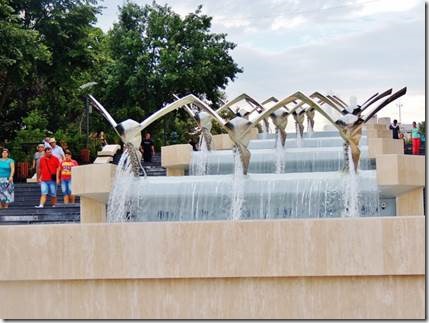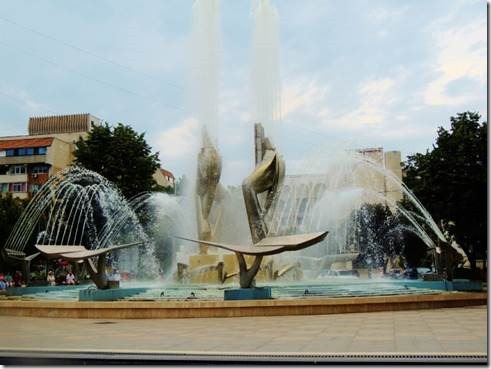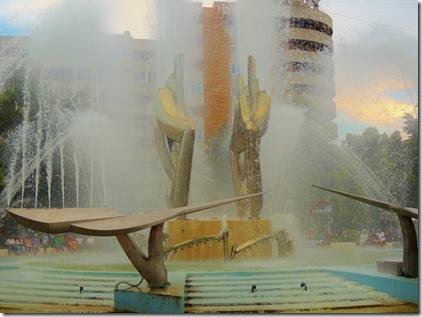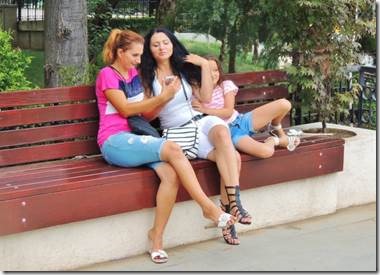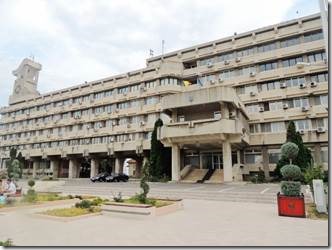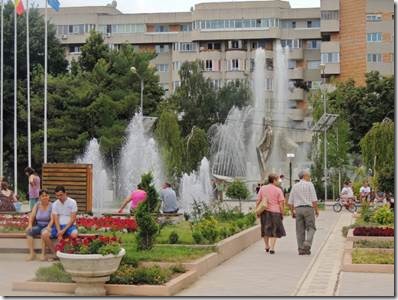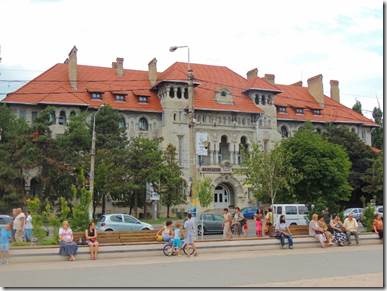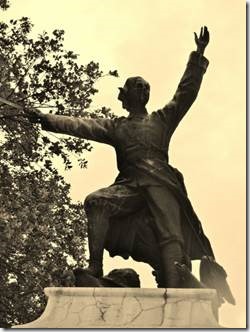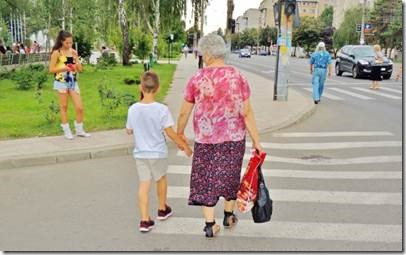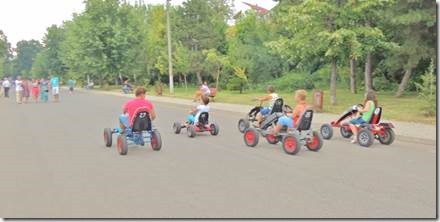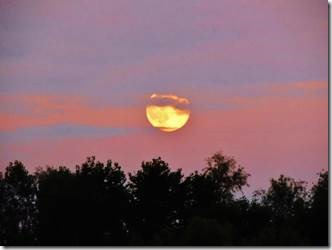Port Tomis, Constanta, Romania
Salut,
Randal and Rick are hooking up everything they took down when we lowered the mast for the river trip. The crane came early afternoon and lickity-split the mast was up before Mary and I were back from the grocery store. Much less stressful than taking it down (especially as I wasn’t there to see;) though making sure everything gets hooked up exactly right is stressful. Thankfully it’s only in the low 80s with a breeze so working out on the bow in the sun isn’t awful. The sails need to be put back. ( I have no idea the nautical term as I’m not a sailor;) and the paravane arms and fish as well.
Tomorrow evening we’ll take off for Bulgaria on an overnight passage.
From the start of this journey, I’ve been a somewhat reluctant participant. But I’ve enjoyed Eastern Europe for some reason I’m hoping to explain to myself one day. One or even two more days in Braila would have been nice, though exploring in the afternoon heat is not so fun. But the only cruising months are those we’ve chosen, so hot weather is unavoidable. Seeing the old town on a work day would have been more interesting than Sunday with the small shops closed up and few people about.
Romania was an ally during WW2. For their trouble they were placed under the Russian sphere of influence. In Sulina we were welcomed by a Romanian lawyer who said, “We’ve been waiting for you since 1945!” No Yankee Go Home in this part of the world or any we’ve been in actually. I certainly hope we give as warm welcome to people who visit the US.
Ru
“Being from Braila is not a Choice, It’s a Destiny
In and of itself being from Romania is a destiny. Not just because you’re born there, but because when you care enough, your whole life is dominated by that unique love-hatred relationship you have with your country. Although individually many experience that tormented, dual feeling regardless of their place of origin, I would say that Romanians are characterized by a combination of national (sometimes even nationalist) pride and self-loath, not very dissimilar from the rest of the Balkan nations, but certainly exacerbated by the long years of nationalist-communist propaganda under Ceaușescu—the former—and by equally long years of negative stereotyping of Romania and Romanians—the latter.
There are, however, pockets of regional pride in Romania, cities and counties which are animated by the goal of bringing themselves up to the standards advocated and demanded by the European Union and all other international organizations that now regulate and monitor Romania’s development. Most of these places are in the historical region of Transylvania, a melting pot of sorts of Romanians, Hungarians, Szekelys, Saxons, Serbians, Slovaks and other ethnic groups. There, places like Cluj-Napoca, the old Transylvanian capital, Sibiu, Brașov, to name a few, have developed better than the rest of the country, and can now easily be associated with any other midsize town from the former Austro-Hungarian Empire. In the last two decades, they rebuilt, restored, recreated old places, reinvented old legends and promoted an international image based on their historical and cultural heritage.
When it comes to South-East Romania though, at the opposite corner of the country from the success stories above, and especially to the Lower Danube area, where the mighty European river prepares itself to share its waters with the Black Sea and forms the Danube Delta, things did not go so well. The oldest and most representative city for the riverine culture and history of the region is my hometown, Braila.
Home to about 170,000 inhabitants, making it about the tenth largest city in Romania, Braila has a long history. Although the city is not mentioned in official documents until 1368, its existence at the mouth of the Danube is probably significantly older. For all intents and purposes, Braila is preparing to celebrate its 650th anniversary of documented existence in 2018. Sandwiched between the historical principalities of Moldavia (now shared between Eastern Romania, Moldova and Ukraine) and Wallachia (now Southern Romania), Braila started out as a fishing community only to expand into a prosperous trading center by the time of the first documents mentioning its existence in the 14th century. Conquered by the Ottoman Empire in 1538, the city was reorganized as a kaza, an Ottoman stronghold and citadel on the border between Moldavia and Wallachia, only to be returned to Wallachia in 1826. The Russian protectorate of the city, led to the complete destruction of the old citadel, and the re-urbanization of Braila into a modern city, following the urban planning used for Odessa. While this led to a prosperous next hundred years in the city’s history, it also wiped out its entire Ottoman heritage. Braila’s golden age of economic prosperity and international recognition as the most important port at the mouth of the Danube ended abruptly with World War II and the ensuing brutal Soviet occupation.
As one of the most successful business communities of prewar Romania, Braila was considered a hotbed of bourgeois capitalism and was treated like an enemy of Romania’s new occupation forces. Its 19th century buildings, former homes to some of the wealthiest entrepreneurs in Romania, were left to slowly decay or were outright demolished to make room for god-awful eyesores of boxy residential buildings that now dominate the architectural urban space of most of the former Eastern Europe. Until the 1970s, Braila was left to fall behind economically as well, probably as a punishment for its former economic prowess. From the pearl of the Danube, Braila turned into a ruin slowly but surely, and only recently local authorities started an ample, but somewhat misguided process of reconstruction.
This history, which no matter how much you try cannot be compressed in a few lines, is what makes those of us coming from Braila feel our hometown as a destiny, a burden and a joy in the same time. The overwhelming responsibility to honor and salvage Braila’s history from oblivion is the former, and the vision of the future and the certainty that it can come to be, the latter.
But for that vision to come into being, Braila’s civil society and local administration, its political organizations, its cultural and educational institutions, its business leaders and entrepreneurs must come together and design a strong and realistic long-term development strategy. From the reconstruction of the old downtown and its revitalization, to the old harbor and the Danube promenade, to the restoration of the old Ottoman catacombs that snake in all directions under the city and even the rebuilding of some of the old ottoman citadel walls to a coherent strategy for major infrastructure projects, for the spa town of Lacu Sărat, for the natural reservation island of Insula Mică a Brăilei, and for new entertainment projects, such as water parks, shopping areas, picturesque pubs and bars, Braila has enormous potential for development. All it needs is will, love for what the city is and what it can become, and funding, which should not be difficult to obtain.
How many of us are ready to accept Braila’s challenge and make its future their destiny? I did it for some years now, and I will continue to do it, but I cannot do it alone.”
|
We finallytied up here at 1 pm after fighting the currents. We’d tied up to a different dock but was told it was private so had to leave. This dock was nearer the old part of the city. There were no power or water hook-ups so we knew our stay would just be overnight. We were able to snag wifi from a restaurant down the waterfront. We closed up the boat and set off for lunch in the old town area. “In the early 19th century, Turks, Romanians, and many Greeks, especially merchants, Armenians and Jews lived in the city. Since the early 1830’s, many more Greeks, basically traders and craftsmen, settled down in Braila, and quickly dominated the economic life of the city. The number of Greeks in the second half of the 19th century, was about 5,000, representing 10% of the city residents. In this time, Braila was the largest port in the country and an important industrial center. The Greek people dominated the field of flour industry. We should mention that four out of the five modern mills in the city, belonged to greek families: (The Galiatsatou brothers, John Millas and Son, Christophoratou etc). The Greek mills were among the most modernized in Romania and in contrast to the flour mills of Bucharest, they were directed to exports. Until the eve of the Second World War, there had been established some other units, such as Panayis Violatos’ flour mill and that of Lykiardopoulos-Valerianos, the largest in Romania. Shipping Throughout the Ottoman period, Braila was a notable commercial center, mainly as a port exporting cereals and other agricultural products. In 1837, the number of ships that had sailed to the port reached 448. The ships under Greek flag had the strongest presence in the commerce. A. Petalas, Th. Faraggas and I. Lykiardopoulos were among the most important Greek merchants. The main activity of the greek community of Braila, was, however, the riverboats. Some of the greatest owners of barges (slepion) were Manuel G. Chrysovelonis, Stathatos Brothers, Othon Stathatos and many others. Massive flight of Greeks in 1950-1951 In 1950-1951, we have the decline of the Greek community. Approximately 50% of the Greek people who lived in Braila decided to leave the city because of the change in the political status. Some of them moved to Greece, others to Australia or America, leaving all their fortune behind. One of the consequences was the definite closure of the Greek schools in the area.” |
|
Art deco? I’m not sure, but the doors and window grates were lovely. The streets between the river and the “old town area” had seen better days, but some buildings still had lovely architectural freatures. |
|
The Blue Clock its one of the city landmarks. Built in 1909 by a clockmaker from Prague, its located in Traian square, right in the middle of the historic center. http://www.dreamstime.com/ |
|
Bank of Romania across the road from the Greek Church |
|
“Owned by the Greek community, the Evangelismos church was built between 1863-1872 by the architect Abraham Ioannidis, originating from Prussa, Asia Minor. He himself supervised the construction of the church by Italian builders and craftsmen. The Church has the form of a cross, with two domes and its dominant style is Greek – Byzantine, with Gothic and Renaissance details. The murals at the central dome were painted by Gh. Tattarescu in 1872. Constantine Livadas-Liokis from Cephalonia painted another part of the church in 1901 and finally, in 1945 – 46 Velissarios completed the murals.” http://www.aionion.gr/en/historical-data/ |
|
The old town architecture. Architecture “The old center of the city has many 19th century buildings, some of them fully restored. The most important monuments are the Greek Church, erected at 1865 by the Greek community, the „Sfintii Arhangheli” Church (the oldest in the city, begun in 1667, the former mosque was transformed into an Orthodox Church in 1808), the 19th century „Sfantul Nicolae” Church, also from the 19th century, the „Maria Filotti” theatre, the Palace of Culture and its Art Museum, the History Museum, and the old Water Tower. The latter houses a restaurant with a rotation system (360° in one hour). Early in 2006 the municipality received European Union funds to renovate the old center of the city, aiming to transform Braila into a major tourist attraction of Muntenia. Tourists who get to Braila can also visit many interesting places like: Public Garden, a park situated above the bank of the Danube with a view over the river and the Macin Mountains, Monument Park, Natural Sciences Museum situated on Park Highway, the Mini-Zoo, Independence Square, Braila Museum form Traian Square, the statuary group Traian, built by the sculptor Tache Dimo – Pavelescu on celebrating 1800 years from the conquest of Dacia, the clock in the city centre, dating since 1909, Kinetic Fountain situated in the city’s civic centre ,which is the "brainchild" of the famous Romanian sculptor Constantin Lucaci, also known as the "2nd Brancusi". Kinetic Fountain is a fantastic and eye-catching example of kinetic art, optical art, programmed art and neoconstructivism.” http://ec.europa.eu/ |
|
Red and Green Travelocity gnomes on a balcony in Braila |
|
Sunday afternoon seemed to generate little activity and most small shops in the area were closed |
|
Second Hand from some well known shops. |
|
A great balcony to people watch |
|
Ana Aslan was born in Braila Ana Aslan (1897-1988, born in Braila) studied at the Faculty of Medicine in Bucharest (1915-1922). She was professor of Cardiology at the Faculty of Medicine in Timisoara (1945-1949). Between 1949 and 1952 she was head of department at the Institute of Endocrinology in Bucharest. Starting in 1952 she became General Director of the Institute of Geriatrics. As one of the pioneering scientists in the world on medical gerontology, Ana Aslan focused also on social gerontology. Ana Aslan proposed systematic countermeasures in order to create a system to stimulate third-age people’s activities. Ana Aslan became aware of the long-term biotrophic action of Procaine and introduced it as a medicine to be taken in small quantity on long terms, for curing and prophylactic benefits. The Gerovital H3 is the first Romanian original biotrophic product and also the first medicine designed to delay human aging processes. It was developed between 1946 and 1956 by Prof. Ana Aslan and her followers, as a result of numerous clinical and experimental studies. http://www.ana-aslan.ro/#!biografie-ana-aslan-uk/c1v6d “J Am Geriatr Soc. 1975 Aug;23(8):355-9. Effects of a procaine preparation (Gerovital H3) in hospitalized geriatric patients: a double-blind study. Zwerling I, Plutchik R, Hotz M, Kling R, Rubin L, Grossman J, Siegel B. Abstract The effects of Gerovital H3 (a specially stabilized form of procaine hydrochloride) on geriatric psychiatric patients were assessed in a double-blind study at Bronx State Hospital. The mean age of the subjects was 73 years and the average rating for the severity of organic symptoms was "moderate." During the first six weeks of study, the patients were each given a 5-ml injection of either Gerovital or placebo (saline) intramuscularly three times a week. This dosage was doubled to 10 ml per injection during the second six weeks. Nine Gerovital and 10 control subjects completed the first six weeks; and 6 Gerovital and 7 control subjects completed the entire 12-week study. Objective rating scales were used to evaluate patients on measures of interpersonal functioning, cognitive ability, psychiatric symptoms, and urine and blood chemical findings. All subjects were assessed before treatment and at six weeks and twelve weeks of the study. Side effects were recorded at two-week intervals. On most measures the variability between subjects was quite large, whereas differences between average scores for the two groups usually were small The few significant differences showed no systematic pattern and would be expected to occur by chance alone when so many statistical comparisons are made. The overall results of this double-blind study strongly indicated that, among these hospitalized geriatric patients with organic symptoms, Gerovital H3 had no ameliorative effect on either psychologic or physiologic functioning.” http://www.ncbi.nlm.nih.gov/pubmed/1097490 Gerovital H3: Banned Fountain Of Youth Drug Favored By Hollywood Makes A Comeback By News Staff | July 3rd 2013 “Gerovital H3, one of the "fountain of youth" miracles drugs that crop up once a generation, was banned in the United States in 1982, but the alternative medicine crowd that never let go of homeopathy after hundreds of years is reviving it. The FDA can’t always protect people, of course. Communist Romania engaged in state-sponsored marketing of Gerovital H3. In 1956, a paper titled "A new method for prophylaxis and treatment of aging with Novocain-eutrophic and rejuvenating effects" was published in the now discontinued journal Therapiewoche by Ana Aslan, director of the Geriatrics Institute of Bucharest and the communist regime established an anti-aging resort and clinic for foreigners. It’s not perfect, but the FDA remains the best scientific food and medicine body in the world.” |
|
We walked to old town looking for lunch. Sadly, while we were eating some very persistent “Roma/gypsi “ girls came begging. The ony way they would leave is when the waitress said she would call the police. You are torn as to how to handle the situation. “THE Roma community is beeing chased from countries across Europe. Romania and France have sent Roma back and forth since 2007, when Romania joined the European Union, but it seems that the French are now intending to pursue a harder line towards the Roma from Romania in their country. On September 12th, Manuel Valls, France’s interior minister, and Bernard Cazeneuve, the minister for European Affairs, travelled to Romania to discuss Roma integration with the country’s president and prime minister. The visit was expected to bring some concrete proposals on how to improve the integration of the estimated 400,000 Roma living in France (a large part of whom are from Romania). Yet they only struck a framework agreement that allows some 80 Roma families who wish to return to Romania to receive “financial support for economic reinsertion” by the French authorities…….Mr Ponta said the real solution to the problem is education and jobs: children from Roma communities need to attend school regularly and Roma need to find stable jobs in Romania. …..Gelu Duminica, the head of the “Impreuna” Agency for Community Development, a foundation that supports the integration and development of the Roma community, says five of their programmes that are financed through the EU are currently suspended because the Romanian government didn’t make payments:” “From the time they entered Europe from India a thousand years ago, the Roma were targets of discrimination. Countries passed laws to suppress their culture and keep them out of the mainstream — and sometimes went much further. Roma were enslaved in Hungary and Romania in the 15th century and targeted for extermination by Nazi Germany 500 years later.” http://edition.cnn.com explains the people called “Roma.” |
|
After lunch and a quick trip to the grocery store, we returned to the boat. Randal’s ATM processing company as well as mine refused to allow us access to our accounts in Romania without email confirmation. Ricks’s card had worked but was limited by the machine’s limits. So we didn’t have so much money to squander. (The situation was resolved by our next stop, Tulcea.) It was quite hot so sitting around under fans resting was about the only thing to do. In the evening we set out for a walk and that’s when Braila comes alive. Lots of folks out for Sunday evening strolls in the cool dusk. Dinner is a late affair: 9 or 10 pm. That’s fine for Rick and Mary, but Randal and I are ready for bed about that time. By 8pm I’m usually not hungry. We actually did stop for a snack and I had some wonderful grilled vegetables. A greenway/park followed the river front |
|
The early evening drew out the citizenry to the park and restaurants along the way. |
|
Seagulls or aliens? |
|
A fountain with moving parts fascinated us Kinetic Fountain situated in the city’s civic centre ,which is the "brainchild" of the famous Romanian sculptor Constantin Lucaci, also known as the "2nd Brancusi". Kinetic Fountain is a fantastic and eye-catching example of kinetic art, optical art, programmed art and neoconstructivism.” |
|
The work of the famous Romanian sculptor Constantin Lucaci, called by many "the second Brancusi?. Lucaci remains, above all, the sculptor in stainless steel. Commissioned in 1988, the impressive fountain depicting two hands, that move and join. The of Ancient, Renaissance and Enlightened traditions are combined by the architect. Neoconstructivism, kinetic art, optical art, art scheduled, new materials, all contribute to the achievement of a large sculpture and a monumental work. Elements that define the force of the artist’s sculpture are the material – stainless steel unalterable – the lightning vibrations exploring the polished surface, the movement, the sonority and also the project itself – that of a sculpture of urban integration. http://www.romguide.net/Visit/Kinetic-Fountain_vt28c They looked like Oscar statuettes made subtle movements as did the whale’s tale looking things |
|
Lots of folks were out enjoying the evening |
|
Braila city’s new center where this small boy was far more interested in the planter than the fountains. |
|
Ecaterina Teodoroiu statue in the new city center Ecaterina Teodoroiu (Romanian pronunciation: [ekateˈrina te.odoˈroju]; born Cătălina Toderoiu; January 15, 1894 – September 3, 1917) was a Romanian woman who fought and died in World War I, and is regarded as a heroine of Romania. In Romanian historiography, Ecaterina Teodoroiu is placed in the context of gendered experience of the Great War on the Eastern Front, on the same pedestal as Queen Maria of Romania. She was born in the village of Vădeni (nowadays part of Târgu Jiu), in the historical region of Oltenia, in Southern Romania. After studying for 4 years in Vădeni and Târgu Jiu and graduating from the Girls’ School in Bucharest, she was to become a teacher when the Romanian Kingdom entered World War I on the Allied side, in 1916. In October 1916, Ecaterina joined the Romanian Army during the first Jiu battle when General Ion Dragalina’s 1st Army repulsed the 9th German Army offensive. A Scouts’ member, she had initially worked as a nurse but she subsequently decided to become a front-line soldier, being deeply impressed by the patriotism of the wounded and by the death of her brother Nicolae (Sergeant in the Romanian Army). It was an unusual decision for a woman of that epoch, so she was sent to the front rather reluctantly. However, soon she proved her worthiness as a symbol and as a soldier. She was taken prisoner but managed to escape by killing two, or perhaps three German soldiers. In November, she was wounded and hospitalized, but came back to the front where she was soon decorated, advanced in rank to Sublocotenent (Second Lieutenant) and given the command of a 25-man platoon. For her bravery she was awarded the Military Virtue Medal, 1st Class. On September 3, 1917 (August 22 Old Style), she was killed in the Muncelu-Varnița area, during the last phase of the Battle of Mărășești (in Vrancea County), where she was hit in the chest by German machine gun fire. According to some accounts, her last words before dying were: "Forward, men, I’m still with you!" She was buried in the city center of Târgu Jiu, and her grave is honored by a monument erected in 1936 by Miliţa Petraşcu. Wikipedia http://en.wikipedia.org/wiki/Ecaterina_Teodoroiu |
|
A print-mixing fashionista and her grandson. |
|
Pedal and motorized go-karts along the river promenade. At times they were more like dodge cars. |
|
Super-moon August 10th “Sunday’s “super moon” will be the biggest and closest full moon of 2014, with scientists are saying there will not be a closer full moon until November, 2034. It will be a perigee full moon, meaning it is near earth and will appear 30 percent brighter and 14 percent bigger.” Read more at http://guardianlv.com/ |

